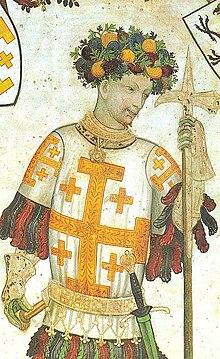長柄斧
此條目需要补充更多来源。 (2019年12月3日) |
東方與西方都有名稱或字義為長柄斧的武器,但兩者形制不同。東方的長柄斧是宋朝用來對付重甲騎兵的武器,明代《武備要略》亦有紀載。[1][2]


西方的長柄斧,或稱頭斧(pollaxe、poleaxe、pole-axe、pole axe、polax、hache)是歐洲中世紀步兵常用的長柄武器。
關於其名稱,現今的詞源學者有兩派說法,一派認為該名稱poll是指「頭」的意思,可能用於標示其特殊頭部形狀或指這種武器是用來砍頭。[3][4];另一派則認為此名稱是長柄斧(poleaxe)的意思。[5]
在14世紀與15世紀時,為了要擊穿板甲而設計出了長柄斧。柄通常長1.2公尺至2公尺,裝著鋼製的斧身,設計因其部件的可替換而差異很大,打擊面通常是一個斧頭或錘子,其反面則是尖刺、錘子或鉤子;而頂端則加上一個側面看起來像匕首的尖刺。
長柄斧常常與斧槍(Halberd)混淆,長柄斧的斧刃通常比斧槍的斧刃來得小,使動能被集中在更小的撞擊面,更適合擊穿厚重盔甲。而有寬斧刃的斧槍通常用來對付較輕薄的盔甲。斧槍的槍身與斧身常是被鍛造成一體,而長柄斧的槍身與斧身則是分開可拆換的。[6]
參見
编辑參考
编辑- ^ 林志隆、陳鈺祥,《宋遼夏金元兵器研究初稿》,第27頁,文史哲出版社。
- ^ 程子頤,《武備要略》,卷八,第45頁。
- ^ The Oxford English Dictionary gives the following etymology, s.v. Poleaxe:
- [ME. pollax, polax, Sc. powax = MDu. polaex, pollaex, MLG. and LG. polexe, pollexe (whence MSw. 15th c. polyxe, pulyxe, MDa. polöxe), f. pol, POLL n.1, Sc. pow, MDu., MLG. polle, pol head + AXE: cf. MDu. polhamer = poll-hammer, also a weapon of war. It does not appear whether the combination denoted an axe with a special kind of head, or one for cutting off or splitting the head of an enemy. In the 16th c. the word began to be written by some pole-axe (which after 1625 became the usual spelling), as if an axe upon a pole or long handle. This may have been connected with the rise of sense 2. Similarly, mod.Sw. pålyxa and Westphalian dial. pålexe have their first element = pole. Sense 3 may be a substitute for the earlier bole-axe, which was applied to a butcher's axe.]
- ^ Wise, Terence; Embleton, G.A. The Wars of the Roses. Men at Arms 145. Osprey. 1983: 33. ISBN 0-85045-520-0.
- ^ For instance, Partridge gives the following etymology:
- L Palus, stake becomes OE pal, whence ME pol, pole, E Pole, the ME cpd pollax, polax becomes poleaxe, AE poleaxe: cf AX (E)
- ^ The Poleaxe. [2019-11-21]. (原始内容存档于2021-02-24).